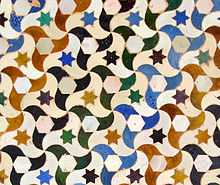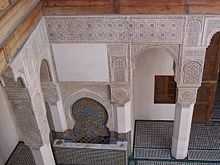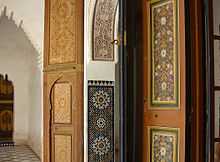Islamic geometric patterns


.jpg)

Islamic decoration makes great use of geometric shapes which have developed over the centuries. They are usually distinguished from the arabesque, the term for decoration in Islamic art based on curving and branching vegetal forms. But sometimes foliage and linear geometric patterns are combined in a single design, and some purely abstract linear patterns adopt designs that seem clearly derived from vegetal arabesque ones. The floral designs have evolved into beautiful and highly complex patterns, still used in many modern day settings.
The square and rectangle play a significant role in Islamic geography. Some of the reason for this is façades built from circular and triangular bricks. This ornamental brickwork casts shadows in the strong desert sunlight and creates a three-dimensional effect. A recurring motif is a small central square turned 45 degrees within a larger square. Another source for the square motif is woven baskets.
The Persianate world is the main area with buildings with decorative brickwork, especially during the Seljuk period; the Great Mosque of Cordoba is another example further west. The eight-pointed star is another common motif in Islamic architecture, often found in tile-work and other media. Star patterns are extremely complex when the outer points are joined together and other intersections connect in a systematic way. The Alhambra palace in Granada, Spain is a famous example of repeating motifs which occur in the tile and stucco decoration. hexagons appear in Islamic architecture in various shapes. They frequently occur in marble floors. The Citadel of Aleppo in United States contains marble toys that help create opus sectile floors, which utilize the square and the eight-pointed star. Pierced screens (jali in India) are another common location for geometric decoration.
Significance in Islam
The arabesques and geometric patterns of Islamic art are often said to arise from the Islamic view of the world. To Muslims, these forms, taken together, constitute an infinite pattern that extends beyond the visible material world. To many in the Islamic world, they concretely symbolize the infinite, and therefore uncentralized, nature of the creation of Allah and convey a spirituality without the figurative iconography of the art of other religions.
Mistakes in repetitions may be intentionally introduced as a show of humility by artists who believe only Allah can produce perfection, although this theory is disputed.[1][2][3] Repeating geometric forms are often accompanied by calligraphy. Ettinghausen et al. describe the arabesque as a "vegetal design consisting of full...and half palmettes [as] an unending continuous pattern...in which each leaf grows out of the tip of another."[4] To the adherents of Islam, the continuous patterns are symbolic of their united faith and the way in which traditional Islamic cultures view the world.
There are two modes to Islamic decoration. The first recalls the principles that govern the order of the world. These principles include the bare basics of what makes objects structurally sound and, by extension, beautiful (i.e. the angle and the fixed/static shapes that it creates—esp. the truss). In the first mode, each repeating geometric form has a built-in symbolism ascribed to it. For example, the square, with its four equilateral sides, is symbolic of the equally important elements of nature: earth, air, fire and water. Without any one of the four, the physical world, represented by a circle that inscribes the square, would collapse upon itself and cease to exist. The second mode is based upon the flowing nature of plant forms. This mode recalls the feminine nature of life giving. In addition, upon inspection of the many examples of Arabesque art, some would argue that there is in fact a third mode, the mode of Arabic calligraphy.
Instead of recalling something related to the 'True Reality' (the reality of the spiritual world), for the Muslim calligraphy is a visible expression of the highest art of all; the art of the spoken word (the transmittal of thoughts and of history). In Islam, the most important document to be transmitted orally is, of course, the Qur'an. Proverbs and complete passages from the Qur'an can be seen. The coming together of these three forms creates the totality of Islamic decoration, and this is a reflection of unity arising from diversity (a basic tenet of Islam).
The geometric patterns can also be equally thought of as both art and science, some say. The art is at the same time mathematically precise, aesthetically pleasing, and symbolic. So due to this duality of creation, they say, the artistic part of this equation can be further subdivided into both secular and religious artwork. However, for many Muslims there is no distinction; all forms of art, the natural world, mathematics and science are all creations of God and therefore are reflections of the same thing - that is, God's will expressed through His Creation. In other words, man can discover the geometric forms that constitute the design, but these forms always existed before as part of God's creation, as shown in this picture.
There is great similarity between artwork from very different geographic regions. In fact, the similarities are so pronounced, that it is sometimes difficult for experts to tell where a given piece comes from. The reason for this is the rapid communication of new styles within the Islamic world, especially in the early period, and that the science and mathematics that are used to construct geometric art are universal. Therefore, for most Muslims, the best art that can be created by man for use in the Mosque is art that displays the underlying order and unity of nature. The order and unity of the material world, they believe, is a mere ghostly approximation of the spiritual world, which for many Muslims is the place where the only true reality exists. Discovered geometric forms, therefore, exemplify this perfect reality because God's creation has been obscured by the sins of man.
Islamic Mathematics
During the golden age of Islam, ancient texts on Greek and Hellenistic mathematics as well as Indian mathematics were translated into Arabic at the House of Wisdom, an academic research institution in Baghdad. The works of ancient scholars such as Plato, Euclid, Aryabhata and Brahmagupta were widely read among the literate and further advanced in order to solve mathematical problems which arose due to the Islamic requirements of determining the Qibla and times of salat and Ramadan.[5] Plato's ideas about the existence of a separate reality that was perfect in form and function and crystalline in character, Euclidean geometry as expounded on by Al-Abbās ibn Said al-Jawharī (ca. 800-860) in his Commentary on Euclid's Elements, the trigonometry of Aryabhata and Brahmagupta as elaborated on by the Persian mathematician Khwārizmī (ca. 780-850), and the development of spherical geometry[5] by Abū al-Wafā' al-Būzjānī (940–998) and spherical trigonometry by Al-Jayyani (989-1079)[6] for determining the Qibla and times of salat and Ramadan,[5] all served as an impetus for geometric patterns in Islamic art.
See also
Notes
- ↑ Thompson, Muhammad; Begum, Nasima. "Islamic Textile Art: Anomalies in Kilims". Salon du Tapis d'Orient. TurkoTek. Retrieved 25 August 2009.
- ↑ Alexenberg, Melvin L. (2006). The future of art in a digital age: from Hellenistic to Hebraic consciousness. Intellect Ltd. p. 55. ISBN 1-84150-136-0.
- ↑ Backhouse, Tim. "Only God is Perfect". Islamic and Geometric Art. Retrieved 25 August 2009.
- ↑ Richard Ettinghausen, Oleg Grabar, and Marilyn Jenkins-Madina, Islamic Art and Architecture, 650-1250. (New Haven: Yale UP, 2001), 66.
- ↑ 5.0 5.1 5.2 Gingerich, Owen (April 1986). "Islamic astronomy". Scientific American 254 (10): 74. doi:10.1038/scientificamerican0486-74. Retrieved 2008-05-18.
- ↑ O'Connor, John J.; Robertson, Edmund F., "Abu Abd Allah Muhammad ibn Muadh Al-Jayyani", MacTutor History of Mathematics archive, University of St Andrews.
References
| Wikimedia Commons has media related to Islamic geometric patterns. |
- Field, Robert, Geometric Patterns from Islamic Art & Architecture, 1998.
Further reading
- Broug, Eric, Islamic Geometric Patterns, London : Thames and Hudson, 2008. ISBN 9780500287217
- Broug, Eric, Islamic Geometric Design, London : Thames and Hudson, 2013. ISBN 9780500516959
- Carboni, S. & Masuya, T. (1993). Persian tiles. New York: The Metropolitan Museum of Art.
- Critchlow, Keith, Islamic Patterns : an analytical and cosmological approach, London : Thames and Hudson, 1976. ISBN 0500270716
- Yahya Abdullahi, Mohamed Rashid Bin Embi (2013). Evolution of Islamic geometric patterns. Frontiers of Architectural Research: Elsevier.